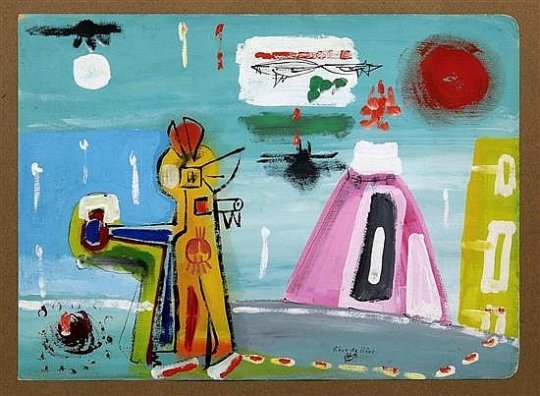#alice paalen rahon
Text
I make a mirror of my open hands / to see you
— Alice Paalen Rahon, from "[Un espalier de larmes non cueillies / A trellis of ungathered tears]," Shapeshifter, tr. Mary Ann Caws
original:
de mes mains ouvertes je fais un miroir / pour te voir
#quote#alice paalen rahon#poetry#shapeshifter#out of my collection#[un espalier de larmes non cueillies / a trellis of ungathered tears]#mary ann caws
342 notes
·
View notes
Link
3 notes
·
View notes
Text
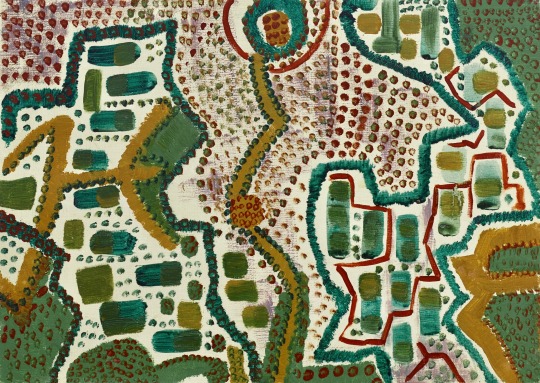
ALICE RAHON (1904-1987)
Pluie
signed, dated and titled 'Alice Paalen, Mexico 42, Pluie' (on the reverse)
oil on canvas
Christie’s
14 notes
·
View notes
Text

Remedios Varo Uranga
Remedios Varo Uranga, née le 16 décembre 1908 à Anglès, dans la province de Gérone en Espagne, et morte le 8 octobre 1963 à Mexico, est une artiste peintre surréaliste espagnole.
Son père est un ingénieur hydraulique. En 1924, Remedios Varo entre à l'Académia de San Fernando où elle étudie les beaux-arts. En 1930, elle participe à une exposition collective à Madrid. Elle épouse le peintre basque Gerardo Lizarraga et ils partent s'installer à Paris.
Elle revient à Barcelone, en 1932, se sépare de Lizagarra et se lie avec le peintre Esteban Francés.
En 1936, Remedios Varo participe à l'exposition Logicofobista organisée à la Galeria Catalonia de Barcelone et rencontre le poète surréaliste français Benjamin Péret, venu combattre avec les anarchistes de la colonne Durutti sur le front de Teruel2. Ils se marient et s'installent à Paris en 1937. Avec Péret, elle fréquente le groupe surréaliste parisien et se lie d'amitié avec l'artiste peintre anglaise Leonora Carrington. Elle présente plusieurs tableaux à l' Exposition internationale du surréalisme de janvier 1938 et à l' Exposition du rêve dans l'art organisée par Frédéric Delanglade. Sa toile El Deseo (Le Désir) est reproduit dans le numéro 10 de la revue Minotaure.
À la fin de l'année 1940, Remedios Varo et Benjamin Péret retrouvent André Breton et quelques surréalistes réfugiés à Marseille, dans la villa Air-Bel, louée par le journaliste américain Varian Fry, dans l'attente d'un visa de sortie du territoire français. Ils parviennent à quitter la France en 1941 pour le Mexique. Elle y retrouve Lizarraga, Francés, Leonora Carrington, Gordon Onslow-Ford, Wolfgang Paalen et sa femme Alice Rahon. Elle crée des publicités pour la compagnie pharmaceutique Bayer, fait de la décoration, peint des meubles et restaure des céramiques pré-colombiennes.
En 1947, elle se sépare de Benjamin Péret qui rentre en France. Elle expose à la galerie Maeght pour l' Exposition internationale du surréalisme.
Après un voyage au Venezuela où elle participe, avec son frère le docteur Rodrigo Varo, à une expédition entomologique, Remedios Varo rencontre Walter Gruen qui l'encourage à peindre à nouveau. Ils se marient en 1953.
En 1955, la Galería Diana de Mexico organise sa première exposition personnelle. En 1958, la Galería Excelsior organise le premier Salon de la Plastica Femina où sont exposées des œuvres, outre celles de Remedios Varo, de Leonora Carrington et d’Alice Rahon. En 1962, la Galería Juan Martín présente sa deuxième exposition personnelle et elle participe à l'Exposition internationale de Tokyo.
Remedios Varo meurt d'une crise cardiaque. Son dernier tableau Nature morte ressuscitant est la seule œuvre sans aucun personnage.
En 1964, une rétrospective est organisée au Musée des Beaux-Arts de Mexico qui attire plus de 50 000 visiteurs. Dans la revue surréaliste La Brèche, André Breton rend hommage à son œuvre « tout entière » surréaliste : « Remedios, la féminité même, ici en hiéroglyphe le jeu et le feu dans l'œil de l'oiseau. »
12 notes
·
View notes
Photo
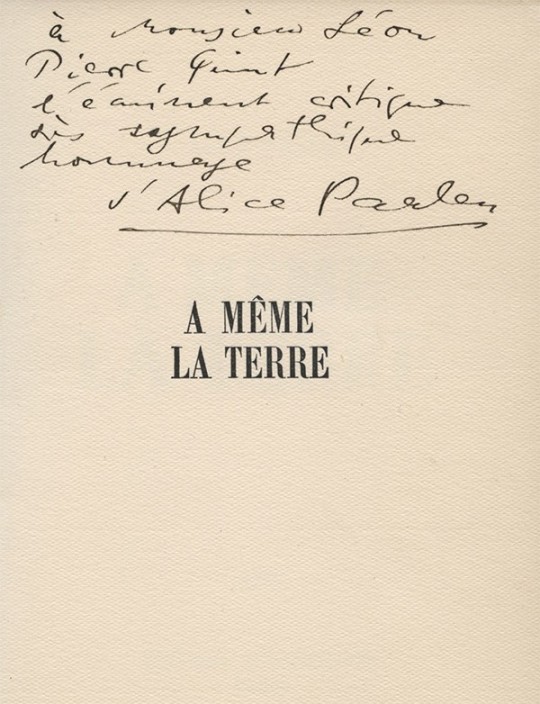
PAALEN (Alice)
A même la terre
Paris, Editions surréalistes, 1936
Petit in-16 (14,7 x 10 cm), couverture bleue rempliée imprimée en violet, 98 pp., 3 ff. n. ch.
Rare édition originale.
Un des 200 exemplaires numérotés imprimés sur vergé (le n° 194).
Bel envoi autographe signé de l'autrice : "à Monsieur Léon / Pierre Quint / l'éminent critique / très sympathique / hommage / d'Alice Paalen".
Le livre a également fait l'objet d'un tirage à 10 ex. sur Japon impérial et 25 ex. hors commerce sur roto bleu foncé. Seuls ces 35 exemplaires comportent une eau-forte de Tanguy en frontispice.
Exemplaire en parfait état.
Directeur des Éditions du Sagittaire pendant plus de vingt ans, Léon Pierre-Quint succéda en 1923 à André Malraux au poste de directeur littéraire de la maison fondée par Simon Kra, poste qu'il partagea durant les premières années avec Michel Soupault.
C'est sous son égide que furent publiés Le Manifeste du surréalisme en 1924 et parmi les premiers ouvrages de René Crevel : Mon corps et moi, La Mort difficile et Babylone.
A même la terre est le premier livre d'Alice Paalen née Rahon (1904-1987), peintre et poète, sa maquette a été réalisée par Benjamin Péret.
3 notes
·
View notes
Text
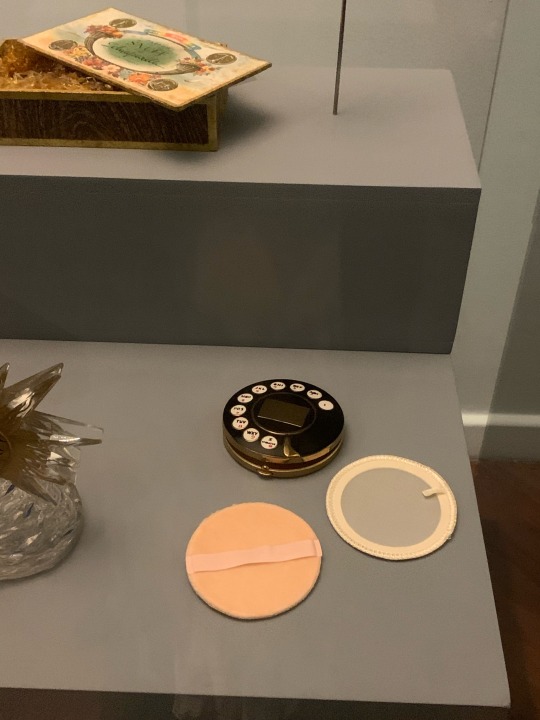


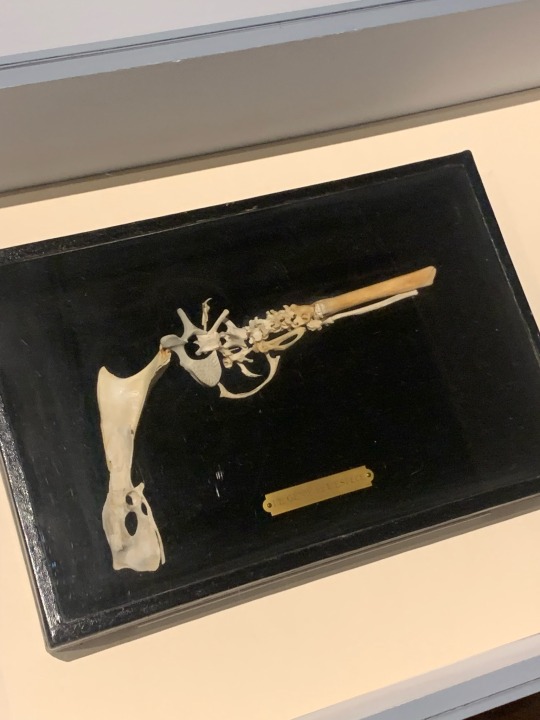
En 1938 el líder de los surrealistas franceses André Breton y su esposa, la artista Jacqueline Lamba, visitaron México. Fueron recibidos por la pareja de artistas Diego Rivera y Frida Kahlo, y pasaron varios meses viajando, conociendo a innumerables artistas e intelectuales mexicanos.
Breton, Rivera y el comunista disidente León Trotsky colaboraron en el Manifiesto por el Arte Revolucionario Independiente, en donde expresaban repudio contra el ascenso del fascismo.
Pronto, sin embargo, el fascismo demostró ser más que una simple amenaza. Con el estallido de la Segunda Guerra Mundial, México se convirtió en la nueva patria de destacados artistas surrealistas como Leonora Carrington, Wolfgang Paalen, Alice Rahon, Remedios Varo, entre otros. Tras concluir la guerra, Edward James, un poeta, mecenas y amigo de los surrealistas, se estableció en México y poco después concibió el jardín escultórico conocido como "Las Pozas™ en la selva cerca de Xilitla, San Luís Potosí.
Esta exposición ofrece una revisión profunda en torno a los principales temas e ideas afines al movimiento surrealista, así como un diálogo inédito entre el surrealismo europeo y su vertiente mexicana. El Museo Boijmans Van Beuningen ha coleccionado principalmente obras maestras europeas de la primera fase del surrealismo. Muchas de estas piezas provienen de la colección de Edward James y otras han sido adquiridas a lo largo de los años. El resto de las obras en la exposición fueron creadas en México y provienen de diferentes colecciones mexicanas.
Una importante comu idad de mujeres surrealistas se encontró en este país que nutrió su interés por el estudio de la arqueología, antropología y diversas vertientes de ocultismo. Sus creaciones, que transmiten una visión que integra el feminismo, la ecología y la magia, añaden nuevas dimensiones al universo surrealista, al tiempo que abordan el papel fundamental que tuvo México durante la segunda fase del surrealismo.
0 notes
Text
NYRB Fall Preview 2020: NYRB Poets
Our fall season includes two bilingual collections of poetry newly translated from the French, by Alice Paalen Rahon and Claire Malroux—both poets who occupy the space between two worlds, be they of language, nation, culture, sexuality, or philosophy.

Alice Paalen Rahon, Alice Paalen Rahon (September)
Alice Paalen Rahon was a shapeshifter: a surrealist poet turned painter who was born French and died a naturalized citizen of Mexico. Bicultural, bisexual, and fiercely independent, her romantic life included affairs with Pablo Picasso and the poet Valentine Penrose. This new selection of Rahon’s poems celebrates the visionary work of a woman who defied easy definition.

Claire Malroux, Daybreak: New and Selected Poems (October)
Claire Malroux holds a unique place in contemporary French poetry, with influences from both the French and Anglophone traditions—especially the work of Emily Dickinson. Her subtle, intimate poems move between an intense, abstract interiority and an acute engagement with the material world. This new volume is a bilingual selection by the award-winning poet and translator Marilyn Hacker.
#alice paalen#alice paalen rahon#alice rahon#claire malroux#poetry#french poetry#poetry in translation#surrealism#surrealist poetry#pablo picasso#valentine penrose#marilyn hacker#nyrb#nyrb classics#new york review books#nyrb poets#literature#books#fall 2020 preview
5 notes
·
View notes
Text
"It is not exactly a book that I am looking at, it's a talisman." @NYRBpoets @maryanncaws #alicepaalenrahon #shapeshifter
“It is not exactly a book that I am looking at, it’s a talisman.” @NYRBpoets @maryanncaws #alicepaalenrahon #shapeshifter
I am very fortunate to receive on occasions review copies of NYRB releases; often these are specific titles I’ve asked for, sometimes they’ve been offered, occasionally they’ll be NYRB Originals rather than Classics. However, NYRB poetry titles have been appearing, which is very exciting and also something of a voyage of discovery! I did request “Magnetic Fields“, which was an excellent…

View On WordPress
0 notes
Text
“Despair will never be reduced to begging even if they burn its arms.” — Alice Rahon
#w#alice rahon paalen#alice rahon#surrealism#surrealist art#surrealist writing#surrealist#women writers
1 note
·
View note
Photo

Man Ray:
Hands of Picasso and Alice Rahon-Paalen, close-up photography
From his close-up photography, drawing for "Les Mains Libres"
Source
17 notes
·
View notes
Text
you have lost and found again
the hot wire of your blood
— Alice Paalen Rahon, from "[Tu as donné ton herbe / You have given your grass]," Shapeshifter, tr. Mary Ann Caws
original:
tu as perdu et retrouvé
le fil chaud de ton sang
#quote#alice paalen rahon#poetry#shapeshifter#out of my collection#[tu as donné ton herbe / you have given your grass]#mary ann caws
330 notes
·
View notes
Photo

A definitive survey of the life and work of a singularly appealing and mysterious surrealist painter
Remedios Varo: The Mexican Years offers a definitive survey of the life and work of a singularly appealing and mysterious Surrealist painter. Born and raised in Spain, Remedios Varo received her earliest training in Madrid before fleeing the Spanish Civil War in 1937 to join Surrealist circles in Paris. The outbreak of World War II forced her to take refuge in Mexico, where she remained until her untimely death in 1963, and where she created her most enduring work. Known as one of the three “brujas” (witches) active in the Mexico City art milieu, Varo shared an interest in esotericism with fellow painter Leonora Carrington and a range of interests in science, philosophy and the literature of German Romanticism with the photographer Kati Horna. For some ten years, from the mid–1950s until her death in 1963, Varo devoted herself to creating an extraordinary dreamlike oeuvre, on the threshold between mysticism and modernity. Her beautifully crafted images of medieval interiors, occult workshops and androgynous figures engaged in alchemical pursuits evoke the eerie allegories of Hieronymus Bosch, esoteric engravings and the charm and lure of fairytales. This catalogue includes a complete illustrated chronology with never before published images and describes Varo’s role in the Mexican Surrealist movement and her relations with Luis Buñuel, Octavio Paz, Benjamin Péret, Alice Rahon, Wolfgang Paalen and many others.
Remedios Varo (1908–1963) fled the Spanish Civil War and then World War II to settle in Mexico where she helped establish a Mexican Surrealist movement and painted visions that combined modernism with mysticism. She was married to the leading French Surrealist Benjamin Péret.
https://www.artbook.com/9788415118220.html
10 notes
·
View notes
Text
"I Like to Put People and Art Together" – Wendi Norris on Connecting with a Wider Audience
by Kim Cabrera • December, 2020

Wendi Norris, photo by Marc Olivier Le Blanc.
-------------------------------------------------------------------------------------------
In the early 2000s, having spent more than a decade working in tech and business, Wendi Norris was feeling burned out and professionally unfulfilled. She began to think about what was missing in her work and why it was leaving her so unsatisfied. “I noticed that the people around me who were doing what they loved were also the ones who were the most successful,” Norris told us.
That realization would lead to the opening of Gallery Wendi Norris, headquartered in San Francisco. Working at first with a business partner, Norris took full control of the gallery around 2011, which allowed her to pursue her own, very specific curatorial vision. The gallery is often associated with the work of Latin American Surrealists, including Leonora Carrington and Remedios Varo. The roster, however, is wide-ranging, incorporating modern artists such as Dorothea Tanning, Wolfgang Paalen, and Alice Rahon with contemporary artists such as Chitra Ganesh, Ana Teresa Fernández, Peter Young, and Ambreen Butt.
Gallery Wendi Norris has a unique business model that is rooted in flexibility and focused on building relationships. Central to the gallery’s vision is a commitment to site-specific, multi-city exhibitions, allowing Norris and her team to travel to wherever they feel will best serve their artists and facilitate connections with collectors, critics, curators, and the public on a larger scale.
We chatted with Wendi about her decision to become an art dealer, her flexible gallery model, and how passion, scholarship, and solid business sense work together to form the gallery’s foundation.
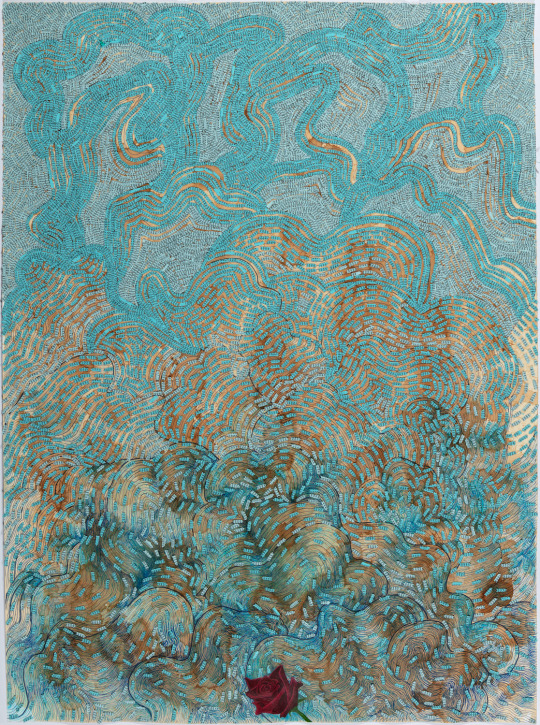
Ambreen Butt, Mohammad Yaas Khan (16), 2019, text, watercolor with white gouache, and pen on tea-stained paper.
-------------------------------------------------------------------------------------------
When did you first become interested in visual arts?
For me, there was definitely an “aha!” moment. I was a junior in college on a study abroad program in Madrid. At the time, my academic interests lay in economics and Spanish. I was allowed to take one elective during the semester, and I somewhat randomly chose art history.
At the end of the first class, my professor said, “We're going to meet on Tuesday at the Prado before it opens.” I had no idea what he was referring to, and I actually raised my hand and asked him what the Prado was. Anyway, I remember being at the museum; I remember being drawn into the fantastic and terrifying world of Goya. But mostly I remember entering a dark gallery, approaching a canvas, and finding myself in front of Velázquez's Las Meninas. I was mesmerized. I had goosebumps. I couldn’t tear myself away from it. I had never seen anything like that. That was the moment, for me, at which an entirely new world opened.
You have this moment at the Prado and you realized that art resonated with you. But you were actually in the tech world for 10 years before you shifted into the gallery world, is that right?
I worked for at least ten years in tech and business before making the shift. During that time, I was primarily working overseas. The first two things I always did upon arrival in a new city were to visit the local market and to find my way to the museums. It's still the way I travel. You can get a very good education in art and culture at markets and museums.
Before I moved to San Francisco in 1999, I lived above an art gallery in Paris. I got to know the owner and a few of his artists really well, and I bought my first piece of art from him.
So, you're back in San Francisco, you've made the choice to leave tech and to open the gallery—what were your initial ideas about what the gallery would be?
I began according to my training and education in business; I wrote a business plan. I still have that plan, tucked away in a private file. My early ambitions were moderate—I just knew that I wanted to be in the art world. But those ambitions started to take shape as I wrote my plan. My early vision was mostly values-based. It was not about wanting to have multiple galleries around the world and sell work at such-and-such a price point. It was more along the lines of, “I want to work with great artists.” It still is. I was also interested in connecting as many people as possible to art by presenting important exhibitions and educating people throughout the process.
In the midst of writing the plan, I organized an exhibition for two of my closest friends who are artists. I invited friends and business colleagues and I sold every single piece. That was really a catalyst for me to say, “OK, I'm doing this.” It was proof that I could do it.
Is that ability to sell a skill set from your previous career? Or is that something, because you're passionate about the work, that came naturally?
In my previous work I was often opening markets for products or investments by launching tech or connecting companies and investors to new global market opportunities. In the art world, I would say I'm a matchmaker; I like to put people and art together. I have strong convictions about my artists, so there’s that. Many of the best dealers that I’ve watched and learned from are first of all just enthusiastic about the work. People respond to that. Great art sells itself. But one also needs to be a good listener. I try to understand what people are thinking and what the obstacles to buying might be for them. I'm not ever really consciously selling, but I am consciously connecting people with art I believe they should consider.

María Magdalena Campos-Pons, El Mensajero, 2011, composition of 12 Polaroid Polacolor Pro 24 x 20 photographs.
-------------------------------------------------------------------------------------------
How do you pick the artists that you're going to show in the program?
I have criteria, but for me it’s ultimately a gut check. I might begin by wondering if there is something I can do for this artist. Can I have a great impact on this artist's career? Their legacy? Is there a story that has not yet been told that needs to be told? Then (and only then), I ask myself if there is a market for this work. Is there a “why this piece, and why now” aspect to it? But first and foremost, the work has to grip me, in the gut. I'm always looking for the “goosebump” effect I had when I was standing in front of the Velázquez. I don't get it every time I go on a studio visit. But when I do, I pay attention.
For my contemporary artists, I have to respect their vision and their work ethic and their code of conduct. I don't need to be their best friend, and I don’t judge—but the relationship ends up being very intimate and personal. I communicate with at least one of my artists almost every day.

Remedios Varo, El malabarista o El juglar, 1956, oil and inlaid mother of pearl on masonite.
-------------------------------------------------------------------------------------------
You're seen as a real champion of Latin American Surrealism. Can you talk a little bit about how that came to be?
My interest in Latin American Surrealism dates back to my previous business partner. He worked on the Leonor Fini estate in Paris in the late ’90s, and he basically brought Fini's work out here to the West Coast. At the time, nobody was really paying attention to her.
And then two things happened. First, Whitney Chadwick, the pioneering scholar who authored Women Artists and the Surrealist Movement, among other seminal books, became a friend to me and a guide of sorts. We met regularly and those long lunches and coffees were immensely formative.
Second, I went to Mexico City shortly after opening the gallery, at Whitney and Susan Aberth’s encouragement. One of the first people I met there was Leonora Carrington. I got to know her well and visited with her over several years, and we did an exhibition together. Leonora had a great influence on me. She and I had lots of discussions, particularly about Wolfgang Paalen, a modern artist now on my roster. His writings and teachings have almost a cult-like following. He really provided me with the conceptual foundation for my program and the foundation that I rely upon even today in the contemporary world. And through Carrington I got to know Paalen’s philosophies because she knew him really well. Everything kind of came from that.

Installation view, Wolfgang Paalen and Abstract Spiritualism, Frieze Masters, Regents Park, Gloucester Green, London, October 6 - 9, 2016, photo by Charlie Littlewood.
-------------------------------------------------------------------------------------------
You had the incredible Carrington show here in New York in 2019, on the Upper East Side.
Yes. That was a lot of effort. I've been working with Carrington’s material for nearly 18 years. I'm involved with the collectors and with the scholars writing and publishing books on her work. And if a museum is looking for something, they'll typically come to my gallery to find it.
That show in New York is a great example of your gallery model. You do site-specific shows in many different cities, not just in San Francisco. Can you talk about the choice to go from a more traditional gallery model to something that's more nimble and responsive?
The process was a fun business challenge for me, given the various changes in the art industry over the past 20 years. I gave myself a lot of time and space to come up with a business model that I felt would work best for me and that could also be adopted by others.
If I had done my 2019 Leonora Carrington show in San Francisco (my third solo show for the artist), what would I have accomplished for Carrington and for the gallery? I don't want to have more real estate, more overhead. But when I revisited my values, the essence of the gallery, I kept thinking about accessibility—my mission to connect people with those artists that I champion.
This offsite gallery model was also born out of working with a culturally rich, internationally diverse roster of artists for the past two decades. How do we echo the global nature of the program without taking on permanent real estate? My team and I also have curated and produced some complex public projects. So I knew that we could problem solve and adapt.

Installation view, Leonora Carrington: The Story of the Last Egg, Gallery Wendi Norris Offsite, 926 Madison Avenue, New York, NY, May 23 - June 29, 2019, photo by Dan Bradica.
-------------------------------------------------------------------------------------------
Art fairs factored briefly in my decision, because fairs have become such a dominant part of the industry, pre-COVID anyway. I always entered an art fair with such excitement and zest and confidence that everything was going to find a home at the end of it. But the fairs always felt short-lived. I always wanted to spend more time with the collectors.
As an example, one of my contemporary artists—Ana Teresa Fernández—is based here in San Francisco and we did a show for her in Miami because I have great collector and institutional relationships there. My team and I were there for six weeks. We were able to build more meaningful relationships with collectors during that period than we had during the fairs themselves.
For the Carrington show in New York, collectors and curators knew who we were, but they also had an opportunity to visit us regularly. We had Roberta Smith and Jerry Saltz in the gallery for hours in total, and it was amazing! I never would have had that kind of experience with them otherwise.
It's about taking that art fair experience, the connections one makes there, and just settling in. I'm a little old-school, and I like developing those relationships because I think it's easier to have one client who supports you across the program than to try to get twenty who periodically support you.
I think the key word there is “relationships.” The gallery is really built on this idea of relationships with the artists, with the clients. Do you put yourself in their cities and their hometowns as a way to open the door for that opportunity?
Yes, a great deal of the success I have enjoyed comes down to that. Even if you're using the digital realm to help you to sell art, and even though that realm is important, it does come down at the end of the day to a relationship. People need to trust your vision. If they acquire a couple of artists from your program, and they're thinking about adding something more to their collection, you want to be one of the people they reach out to when they ask, “Hey, what should I be looking at next?” My team and I have helped to build some fantastic collections over the years. That's because collectors trust us. They come back to us and they refer their friends to us. The relationships that I'm trying to build are long-term.
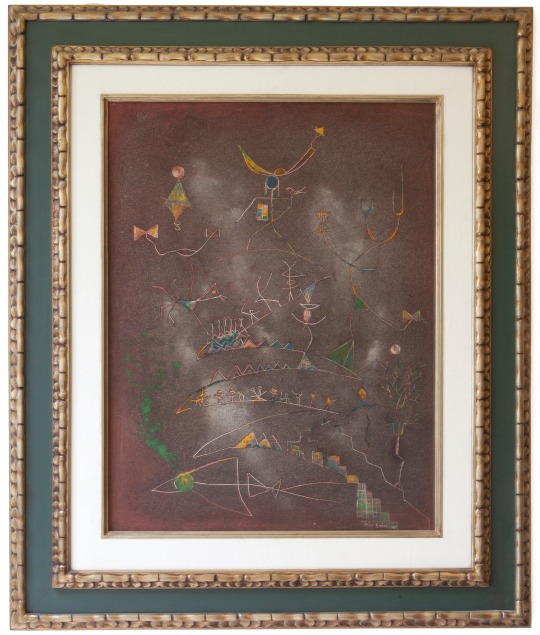
Alice Rahon, Autorretrato con autobiografía (Self-Portrait with Autobiography), 1948, oil and sand on canvas.
-------------------------------------------------------------------------------------------
Do you think that shift to digital is one of the biggest changes that's occurred in the last decade?
One of the biggest changes over the last decade is the speed at which people are being asked to do things. The digital realm has created great global reach but it also creates a race for more likes, more emails, extended digital presentations, or multiple virtual viewing rooms. This digital churn is similar to the art fair churn in that it takes up exponentially more time now than it did ten years ago. That leaves less time for artists, collectors, critical thinking, and better decision making. I would prefer to share that energy with collectors, whether I'm meeting them personally, on the phone, sending thoughtful emails, or on a Zoom call like this. I see an art world that is going very fast in one direction without stopping to slow down and think about the direction in which it’s traveling until it’s forced to do so.

Wendi Norris, photo by Marc Olivier Le Blanc.
-------------------------------------------------------------------------------------------
You and your team have done some beautiful publications. Is that something that has always been important to you from the get-go?
I have a book problem. I have a lot of books. But that’s because I believe in cultural and visual literacy. I believe in education. I come from a family of teachers and professors. Writers and critical thinkers contribute a great deal to our industry, and yet they seem to be the most adversely affected right now. They need support, and they deserve it. Ultimately, the books are for the artists and their admirers, and they serve as a permanent documentation of the work.
Do you have any advice for people just starting out as collectors? Like that moment when you bought your first work from the gallery in Paris?
I tell new collectors, the ones I'm just starting out with, “buy what you love; buy what you can pay for; buy what you can afford.” I may not have that first painting I bought permanently installed in my home, but I think of it with great fondness. One’s eye changes and evolves. I think figuring out what you love in art and making sure that you have some goals in terms of what you want to spend makes collecting a little easier—especially with couples that collect.
Ultimately, I think your vision will serve itself. I never advise people to buy for investment purposes, even though art can often be a great investment. If someone's coming into the art world based on following a trend or for an investment, I think they’re following the wrong path.
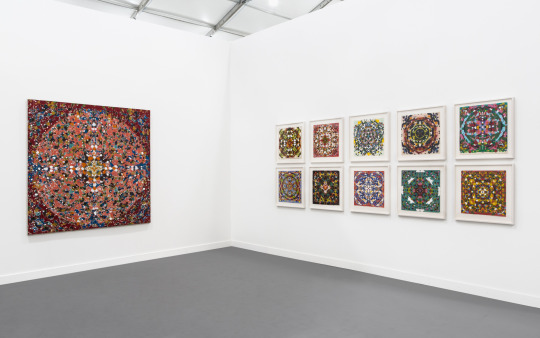
Installation view, Peter Young: Mandala Paintings (1973-74), Frieze New York Spotlight, Randall’s Island Park, New York, NY, May 4-7, 2017, photo by Dawn Blackman.
-------------------------------------------------------------------------------------------
Do you have any advice for young, aspiring art dealers who want to get into the business?
Take your time; work in and around a gallery; do your research. But most importantly, establish a set of values that are important to you and the way you want to run your business. That should go for almost any entrepreneur. Core principles are essential. They are what will set you apart from others and sustain you in the long run.
In the wider world, the one we share, I believe that galleries need to develop a better way of working together. The system should flourish at all levels instead of the same few mega-galleries gobbling up the artists once the small or mid-sized galleries have invested in building their markets. Without a diverse array of galleries, both in terms of geography and size, we will kill the very nature of the business, the ability to discover and nurture artists. I want to enhance the competitive structure by creating more galleries, not more massive, monopolistic-behaving ones.
Would you recommend making a business plan?
Yes, absolutely. The act of writing something down—whether it's a Venn diagram or a bar chart or a set of goals articulating a vision—it’s an essential part of the process. Writing is not recording. It is a fundamentally creative act. It also provides you with the opportunity to ask yourself a series of important questions, not the least of which should be financial in nature. The process of planning, on paper and with words, is crucial to any business. It is especially crucial to a gallery, because you need to understand what it is that's driving you and how you can be successful.
-------------------------------------------------------------------------------------------
All images courtesy Gallery Wendi Norris, San Francisco.
6 notes
·
View notes
Photo

Remedios Varo: The Mexican Years
Remedios Varo: The Mexican Years offers a definitive survey of the life and work of a singularly appealing and mysterious Surrealist painter. Born and raised in Spain, Remedios Varo received her earliest training in Madrid before fleeing the Spanish Civil War in 1937 to join Surrealist circles in Paris. The outbreak of World War II forced her to take refuge in Mexico, where she remained until her untimely death in 1963, and where she created her most enduring work. Known as one of the three “brujas” (witches) active in the Mexico City art milieu, Varo shared an interest in esotericism with fellow painter Leonora Carrington and a range of interests in science, philosophy and the literature of German Romanticism with the photographer Kati Horna. For some ten years, from the mid–1950s until her death in 1963, Varo devoted herself to creating an extraordinary dreamlike oeuvre, on the threshold between mysticism and modernity. Her beautifully crafted images of medieval interiors, occult workshops and androgynous figures engaged in alchemical pursuits evoke the eerie allegories of Hieronymus Bosch, esoteric engravings and the charm and lure of fairytales. This catalogue includes a complete illustrated chronology with never before published images and describes Varo’s role in the Mexican Surrealist movement and her relations with Luis Buñuel, Octavio Paz, Benjamin Péret, Alice Rahon, Wolfgang Paalen and many others.
Remedios Varo (1908–1963) fled the Spanish Civil War and then World War II to settle in Mexico where she helped establish a Mexican Surrealist movement and painted visions that combined modernism with mysticism. She was married to the leading French Surrealist Benjamin Péret.
View on Amazon
28 notes
·
View notes
Photo

Exposition Art Blog Alice Rahon
Alice Phillipot (later Paalen and Rahon) (8 June 1904 – September 1987) was a French/Mexican poet and artist, whose work contributed to the beginning of abstract expression in Mexico. She began as a surrealist poet in Europe, but began painting in Mexico. She was a prolific artist from the late 1940s to the 1960s, exhibiting frequently in Mexico and the United States, with a wide circle of friends in these two countries. Her work remained tied to surrealism, but was also innovative including abstract elements and the use of new techniques such as sgraffito and the use of sand for texture. She became isolated in her later life due to health issues, and except for retrospectives at the Palacio de Bellas Artes in 1986 and at the Museo de Arte Moderno in 2009 and 2014, has been largely forgotten despite her influence on Mexican modern art.
More
0 notes
